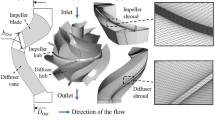Abstract
The coast-down behavior is specially designed to satisfy the certain flow requirements in a special kind of canned motor pump when it is used in primary reactor coolant system. However, coast-down models once used are not suitable for designing ultra-large canned motor pumps with flywheels, in which case rotor’s fluid resistance of canned motor is modeled by an empirical constant. When the size of canned motor increases, the error of empirical relationship becomes remarkable. In thrall to material’s density and strength, flow resistance of coast-down behavior should be dynamically modeled accurately to reduce the demands of materials. In this paper, an improved analytical model is proposed to study barbell-like canned motor’s coast-down characteristic based on basic torque behavior researches in Taylor-Couette flow and hydraulic coupler, where bearing’s resistance is ignored. This model takes geometric and kinematic parameters into consideration. In addition, the influence of pressure and temperature is coupled into this coast-down model by using Reolands’ viscosity relationship. Based on this model, coast-down behavior is studied and parameters sensitivity analysis is conducted from design view point. Parameters sensitivity analysis indicates that the density and distribution of materials have more remarkable influence on coast-down behavior compared with working condition and geometric parameters.
Similar content being viewed by others
References
Schulz T L. Westinghouse AP1000 advanced passive plant [J]. Nuclear Engineer and Design, 2006, 236(14): 1547–1557.
Matzie R A. AP1000 will meet the challenges of nearterm deployment [J]. Nuclear Engineering and Design, 2008, 238(8): 1856–1862.
Sutharshan B, Mutyala M, Vijuk R P, et al. The AP1000TM reactor: Passive safety and modular design [J]. Energy Procedia, 2011, 7: 293–302.
Song J H, Baik J H, Zee S K, et al. Development of a high power three-loop nuclear power plant [J]. Nuclear Engineering and Design, 2010, 240(10): 3621–3631.
Zhang Li-ming. Modeling of npp canned motor pump performance degradation assessment based on multiagent system [C]//Proceedings of the 18th International Conference on Nuclear Engineering. New York: American Society of Mechanical Engineers, 2010: 273–277.
Zhang Sen-ru. Transient behavior calculation for reactor coolant circulation pump [J]. Nuclear Power Engineering, 1993, 14(2): 183–189 (in Chinese).
Deng Shao-wen. Calculation of transient of the reactor coolant pumps for qinshan phase nuclear power plant [J]. Nuclear Power Engineering, 2001, 22(6): 494–496 (in Chinese).
Lathrop D P, Fineberg J, Swinney H L. Turbulent flow between concentric rotating cylinders at large reynolds number [J]. Physical Review Letters, 1992, 68(10): 1515–1518.
Lathrop D P, Fineberg J, Swinney H L. Transition to shear-driven turbulent in Couette-Taylor flow [J]. Physical Review A, 1992, 46(10): 6390–6405.
Lewis G S, Swinney H L. Velocity structure functions, scaling, and transitions in high-Reynoldsnumber Couette-Taylor flow [J]. Physical Review E, 1999, 59(5): 5458–5467.
van Gils D P M, Bruggert G W, Lathrop D P, et al. The twente turbulent taylor-couette (T3C) facility: Strongly turbulent (multiphase) flow between two independently rotating cylinders [J]. Review of Scientific Instruments, 2011, 82(025105): 1–13.
Eckhardt B, Grossmann S, Lohse D. Torque scaling in turbulent Taylor-Couette flow between independently rotating cylinders [J]. Journal of Fluid Mechanics, 2007, 581: 221–250.
van Gils D P M, Huisman S G, Bruggert G W, et al. Torque scaling in turbulent Taylor-Couette flow with co- and counterrotating cylinders [J]. Physical Review Letters, 2011, 106(024502): 1–4.
Kitabayashi H, Li C Y, Hiraki H. Analysis of the various factors affecting drag torque in multiple-plate wet clutches [C]// JSAE/SAE International Spring Fuels & Lubricants Meeting. Yokahama, Japan: SAE, 2003: 1–6.
Yuan S H, Peng Z X, Jing C B. Experimental research and mathematical model of drag torque in single-plate wet clutch [J]. Chinese Journal Mechanical Engineering, 2011, 24(1): 91–97.
Taylor G I. Stability of a viscous liquid contained between two rotating cylinders [J]. Philosophical Transactions of the Royal Society of London. Series A. Containing Papers of a Mathematical or Physical Character, 1923, 223: 289–343.
Taylor G I. Fluid friction between rotating cylinders. I. Torque measurements [J]. Proceedings the Royal of Society A, Mathematical Physical & Engineering Science, 1936, 157: 546–564.
Schartman E, Ji H, Burin M J. Development of couette-taylor flow device with active minimization of secondary circulation [J]. Review of Scientific Instruments, 2009, 80(024501): 1–8.
Dubrulle B, Hersant F. Momentum transport and torque scaling in taylor-couette flow from an analogy with turbulent convection [J]. The European Physical Journal B, 2002, 26: 379–386.
Merbold S, Brauckmann H J, Egbers C. Torque measurements and numerical determination in differentially rotating wide gap Taylor-Couette flow [J]. Physical Review E, 2013, 87(023014): 1–4.
Xiong Yong-qiang, Yin Zhong-wei, Peng Ying-hong. The effects of mechanical properties of bearing bush on water lubricated plastic bearing lubricating property [J]. Lubrication Engineering, 2011, 36(2): 9–11 (in Chinese).
Author information
Authors and Affiliations
Corresponding author
Additional information
Foundation item: the National Basic Research Program (973) of China (Nos. 2009CB724308 and 2015CB057302) and the National Key Technology Research Project (Nos. 2010ZX06001-13 and 2013ZX06002002-017)
Rights and permissions
About this article
Cite this article
Xue, Yb., Yao, Zq., Cheng, D. et al. Coast-down modeling of canned motor based on torque behavior study. J. Shanghai Jiaotong Univ. (Sci.) 20, 420–426 (2015). https://doi.org/10.1007/s12204-015-1643-6
Received:
Published:
Issue Date:
DOI: https://doi.org/10.1007/s12204-015-1643-6




